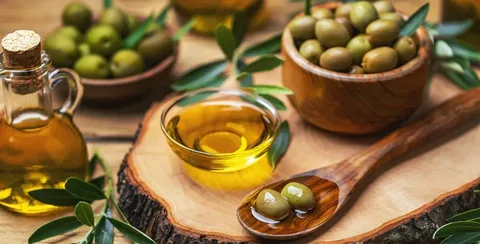Olive Oil Market competitive landscape featuring top players and strategic developments globally

The Olive Oil Market features intense competition among global players, each leveraging innovation, quality, and expansion strategies to gain a stronger foothold in diverse markets.
Overview of the Competitive Environment
The olive oil industry has grown into a highly competitive marketplace, marked by the presence of multinational giants, regional producers, and emerging artisanal brands. With consumer demand evolving rapidly and preferences shifting toward premium, organic, and health-focused variants, companies are focusing on differentiating themselves through product innovation, branding, and global outreach.
While traditional producers in Europe still dominate production volumes, newer entrants in the Americas and Asia are disrupting the market through smart packaging, digital marketing, and localized offerings.
Leading Global Players
1. Deoleo S.A. (Spain)
A dominant force in the olive oil industry, Deoleo owns popular brands like Bertolli and Carapelli. The company leads in terms of global distribution, especially in North America and Europe. Deoleo continues to invest in sustainable sourcing and product transparency to maintain its leadership position.
2. Sovena Group (Portugal)
Sovena produces both consumer and industrial olive oils. Its extensive presence in more than 70 countries and focus on vertical integration — from cultivation to packaging — makes it a strong global competitor.
3. Colavita (Italy)
Colavita is a family-owned brand that has gained international recognition for its high-quality extra virgin olive oils. Known for consistency and authentic Italian production, Colavita remains a preferred brand in the U.S. and Europe.
4. Pompeian Inc. (USA)
With a growing base in North America, Pompeian sources olives globally and emphasizes certified labeling such as USDA Organic and Non-GMO. The brand targets health-conscious consumers with specialty lines like organic and robust-flavored oils.
5. Borges International Group (Spain)
Borges has diversified into a broad range of oils, including specialty blends. The company leverages its Mediterranean heritage and invests in R&D to introduce innovative packaging and flavors.
Regional Competitors Gaining Ground
In addition to established global names, many regional brands are building a strong presence:
-
Australia: Cobram Estate has emerged as a premium olive oil producer with a focus on freshness and domestic sourcing.
-
India: Figaro and Leonardo are two widely recognized olive oil brands appealing to urban Indian households.
-
Turkey & Tunisia: Local producers are increasingly exporting high-quality olive oils to Europe, the U.S., and Gulf countries, capitalizing on favorable growing conditions and government support.
These regional players often emphasize traceability, local farming, and competitive pricing to challenge larger international brands.
Strategic Developments Reshaping Competition
To remain relevant and grow their market share, leading companies are investing in multiple strategic areas:
1. Sustainability and Eco-Friendly Practices
Sustainable farming, recyclable packaging, and carbon footprint reduction are being integrated into brand positioning. For example, Deoleo and Sovena have introduced sustainability certifications and traceability programs that appeal to eco-conscious buyers.
2. Product Diversification
Top brands are expanding their product lines to include:
-
Organic and cold-pressed oils
-
Flavored oils (e.g., garlic, basil, lemon)
-
Cooking sprays and convenient sachets
This not only attracts niche segments but also boosts overall consumption.
3. Geographic Expansion
Many companies are entering emerging markets such as Southeast Asia, Eastern Europe, and Africa through strategic partnerships, direct-to-consumer models, and e-commerce platforms.
4. Digital Marketing and E-commerce Integration
Online presence is now a key battleground. Top brands are engaging customers through recipe blogs, influencer collaborations, and subscription services. They are also optimizing packaging for easier online delivery, minimizing breakage and spillage.
Competitive Challenges and Market Risks
Despite numerous opportunities, companies face several challenges:
-
Price Volatility: Olive oil prices fluctuate based on olive harvests, weather conditions, and geopolitical factors.
-
Brand Imitation and Adulteration: Counterfeit products undermine consumer trust and affect premium brand reputation.
-
Consumer Education: Misunderstandings about oil types and quality levels (e.g., virgin vs. pomace) still exist in many new markets.
To overcome these, market leaders are investing in QR code-enabled traceability, certified seals, and transparent labelling.
Mergers, Partnerships, and Investments
Strategic collaborations and acquisitions are helping brands consolidate operations and expand product lines:
-
Deoleo has formed partnerships with local distributors in Asia to strengthen its retail presence.
-
Pompeian has invested in domestic bottling and blending facilities in the U.S. to reduce dependency on imports.
-
Sovena continues to invest in olive groves across Portugal, Morocco, and Tunisia to control quality from source to shelf.
Conclusion
The olive oil market’s competitive landscape is evolving quickly, shaped by innovation, sustainability, digital presence, and global reach. While European brands maintain legacy dominance, regional challengers are bringing new energy to the market. As demand continues to rise, especially for premium and health-oriented products, companies that prioritize quality, traceability, and consumer connection will be best positioned to lead the market by 2030.
- Art
- Causes
- Crafts
- Dance
- Drinks
- Film
- Fitness
- Food
- Oyunlar
- Gardening
- Health
- Home
- Literature
- Music
- Networking
- Other
- Party
- Religion
- Shopping
- Sports
- Theater
- Wellness


